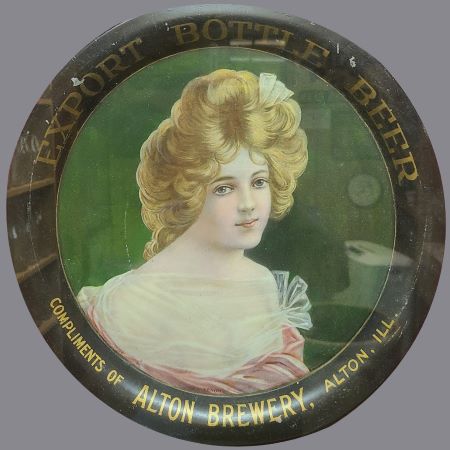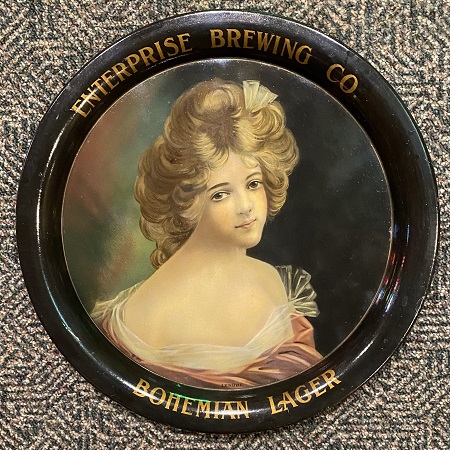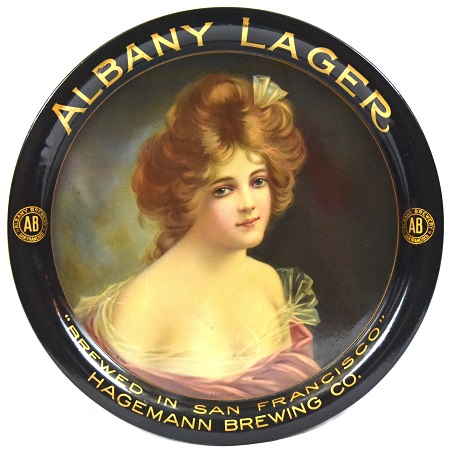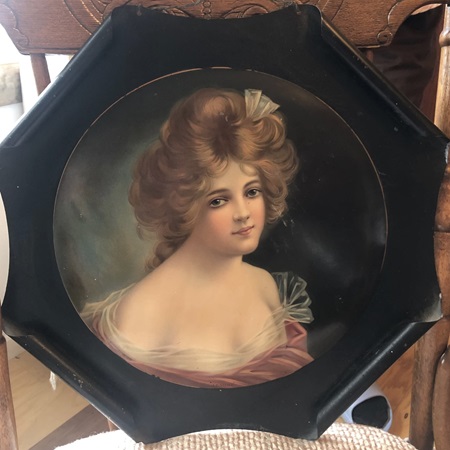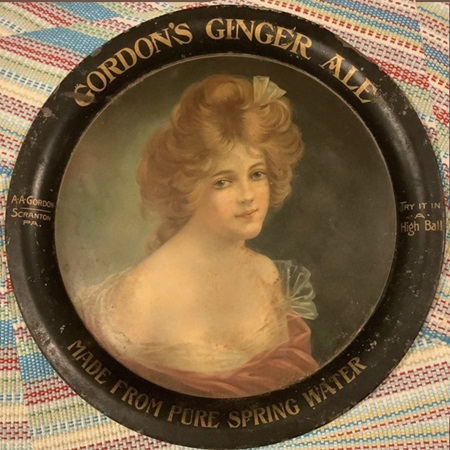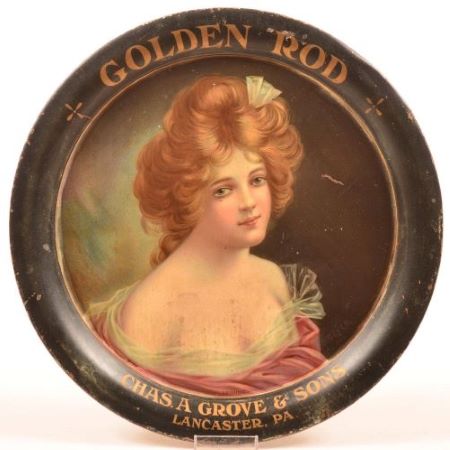The 'Stock' Exchange
The Meek Co.: No. 78 "Lenore"
The Meek Co.: No. 78 "Lenore"
Date: 1907 - 1909
Size: 13"
Type: Inverted Pie
Scarcity: Uncommon
Value: $$$ to $$$$
Condition & Brewer Dependent
Size: 13"
Type: Inverted Pie
Scarcity: Uncommon
Value: $$$ to $$$$
Condition & Brewer Dependent
General
Meek first ventured into the “Victorian Lady” genre with No. 65 “Annabelle” and although it proved very popular, it either took a while for Meek to recognize the demand for this type of design, or it is an indication of the amount of time it took for a design to proceed from an idea to production. Regardless, No. 78 "Lenore" begins a stream of “Victorian Lady” designs which ran through 1907 (with modifications to keep up with the evolving fashions of the times), and then continue to varying degrees through the rest of Meek/AAW’s stock design. Generally speaking, these designs proved to be very popular, particularly with brewers.
Although it does not appear on any tray versions we’ve seen, Dresden Art Plate versions carry the signature “B. Geyer” who was a 19th century Austrian artist about whom little is known. He is believed to have been active in the late 19th to early 20th century. His works, mostly portraits of European/Victorian ladies, appear on porcelain cabinet art plates, particularly from the Ceramic Art Company who frequently sold via Tiffany & Co. We have not turned up an actual porcelain plate with the Lenore design so perhaps Meek acquired the exclusive rights. A 1907 copyright appears on some examples.
At the end of the 1800s up through the 1930s, Lenore enjoyed some quasi-respectable levels of usage (never a Top 300 choice, although she did come close in the 1920s). Oddly enough, this is another name with a strong Edgar Allan Poe connection; in The Raven it appears that the raven’s visit to the narrator is announce the death of his love, “a rare and radiant maiden whom the angels name Lenore,” which rhymes nicely with the only other word spoken by the raven, nevermore. There does not seem to be agreement on origin or meaning of the name. Among the various assertions:
- Lenore is a German variation of Leonora which in itself is a derivation of the Italian Eleonora which means unknown.
- Ellie, Ella, Nora, Norah, Leonora, Lenora and Lenore are all generally considered contracted and/or pet forms of Eleanor. Eleanor is a name made popular by Eleanor of Aquitaine (c. 1122-1204), one of the most glamorous, wealthy, powerful and adventurous women in all of medieval Europe. It’s commonly believed to have been derived from the medieval Provençal (a southeastern French dialect) female name “Aliénor” from the Germanic “aljis” meaning “other, foreign”
- Still, other etymologists surmise Aliénor was merely the Provençal dialectical form of Elena (the Spanish form of Helen). Helen comes from the Greek (Ελένη) from “hēlios” meaning “sun, ray of light” or “the bright one”.
Sahling has an April 1907 entry in his journal for “Lenora, stock tray 13” (which is followed by entries for two other “Victorian Lady” stock designs in May), indicating that purchased artworks still needed to be re-created by a skilled lithographer via the multi-printing lithographic process (recall those early stock designs from Tuscarora described as being “in ten printings”).
Shape & Rim & Ad Text
In tray form No. 78 continues the use of the 13” convex pie shape with all known examples being in this form with the exception of a single square example from Union Brewing of Peoria, IL. Curled corner sign versions are also well represented as are tip trays. Rims are black and advertising text is gold. Some Art Plates also carry advertising, but these are printed on the back.
Hager & Price
Hager discusses this design and other similar “Victorian Lady” designs in “The Ladies” section of his article. He comments on their ubiquity on trays, tips trays, signs and Art Plates. He notes that the Art Plates were introduced in 1907 and produced through 1909; they carry 200-based numbers (starting with #200 for Louise) in the Art Plate format. Interestingly, the sequence of Art Plate numbers does not sync with their stock tray number; for example, Lenore is the first in the series as a tray (No. 78), but the eighth (no. 207) as an Art Plate. No. 78 appears in both his catalog and as an Art Plate in the body of his article. Prices for both trays and signs are modest for brewery examples and generally weak for non-breweries, although the two highest we’ve seen are both for soda/lithia water companies, including more than $900 for a convex pie version for Mecklenburg Sparkling Lithia Water of Chase City, VA.
Meek first ventured into the “Victorian Lady” genre with No. 65 “Annabelle” and although it proved very popular, it either took a while for Meek to recognize the demand for this type of design, or it is an indication of the amount of time it took for a design to proceed from an idea to production. Regardless, No. 78 "Lenore" begins a stream of “Victorian Lady” designs which ran through 1907 (with modifications to keep up with the evolving fashions of the times), and then continue to varying degrees through the rest of Meek/AAW’s stock design. Generally speaking, these designs proved to be very popular, particularly with brewers.
Although it does not appear on any tray versions we’ve seen, Dresden Art Plate versions carry the signature “B. Geyer” who was a 19th century Austrian artist about whom little is known. He is believed to have been active in the late 19th to early 20th century. His works, mostly portraits of European/Victorian ladies, appear on porcelain cabinet art plates, particularly from the Ceramic Art Company who frequently sold via Tiffany & Co. We have not turned up an actual porcelain plate with the Lenore design so perhaps Meek acquired the exclusive rights. A 1907 copyright appears on some examples.
At the end of the 1800s up through the 1930s, Lenore enjoyed some quasi-respectable levels of usage (never a Top 300 choice, although she did come close in the 1920s). Oddly enough, this is another name with a strong Edgar Allan Poe connection; in The Raven it appears that the raven’s visit to the narrator is announce the death of his love, “a rare and radiant maiden whom the angels name Lenore,” which rhymes nicely with the only other word spoken by the raven, nevermore. There does not seem to be agreement on origin or meaning of the name. Among the various assertions:
- Lenore is a German variation of Leonora which in itself is a derivation of the Italian Eleonora which means unknown.
- Ellie, Ella, Nora, Norah, Leonora, Lenora and Lenore are all generally considered contracted and/or pet forms of Eleanor. Eleanor is a name made popular by Eleanor of Aquitaine (c. 1122-1204), one of the most glamorous, wealthy, powerful and adventurous women in all of medieval Europe. It’s commonly believed to have been derived from the medieval Provençal (a southeastern French dialect) female name “Aliénor” from the Germanic “aljis” meaning “other, foreign”
- Still, other etymologists surmise Aliénor was merely the Provençal dialectical form of Elena (the Spanish form of Helen). Helen comes from the Greek (Ελένη) from “hēlios” meaning “sun, ray of light” or “the bright one”.
Sahling has an April 1907 entry in his journal for “Lenora, stock tray 13” (which is followed by entries for two other “Victorian Lady” stock designs in May), indicating that purchased artworks still needed to be re-created by a skilled lithographer via the multi-printing lithographic process (recall those early stock designs from Tuscarora described as being “in ten printings”).
Shape & Rim & Ad Text
In tray form No. 78 continues the use of the 13” convex pie shape with all known examples being in this form with the exception of a single square example from Union Brewing of Peoria, IL. Curled corner sign versions are also well represented as are tip trays. Rims are black and advertising text is gold. Some Art Plates also carry advertising, but these are printed on the back.
Hager & Price
Hager discusses this design and other similar “Victorian Lady” designs in “The Ladies” section of his article. He comments on their ubiquity on trays, tips trays, signs and Art Plates. He notes that the Art Plates were introduced in 1907 and produced through 1909; they carry 200-based numbers (starting with #200 for Louise) in the Art Plate format. Interestingly, the sequence of Art Plate numbers does not sync with their stock tray number; for example, Lenore is the first in the series as a tray (No. 78), but the eighth (no. 207) as an Art Plate. No. 78 appears in both his catalog and as an Art Plate in the body of his article. Prices for both trays and signs are modest for brewery examples and generally weak for non-breweries, although the two highest we’ve seen are both for soda/lithia water companies, including more than $900 for a convex pie version for Mecklenburg Sparkling Lithia Water of Chase City, VA.


Confirmed Brewer used Stock Trays
Non-Beer Related & Non-Tray Uses
Click the Picture to Return to Meek & Beach Stock Catalog Page
